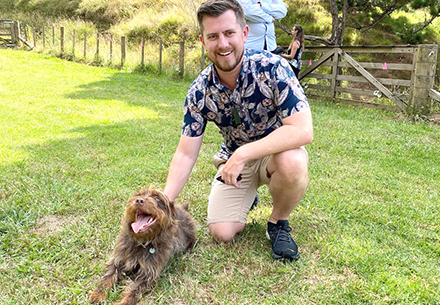Four-year old English springer spaniel Pip and 5-year-old terrier Mawhai are being phased into operation, which will begin with the testing of soil samples from possibly infected kauri trees. Source: Stuff NZ
A select few people including Auckland mayor Phil Goff were invited to watch the dogs in action at the remote training facility in Huia. Mr Goff was impressed by the success of the program and described the day as a “special occasion”.
“These dogs are really important to us. They’ll be able to help us further protect islands in the Hauraki Gulf, like Waiheke, which is still free from kauri dieback disease,” he said. During the event Pip and Mawhai tackled two courses, sniffing out kauri dieback samples from soils and a pair of rubber gloves.
Since February 2020, the council has spent just shy of $50,000 training the two dogs and their handlers to detect the disease in a range of materials, including tree roots.
“It was a challenging assignment for the dogs and for us as trainers,” lead handler Brian Shields said.
“Dogs are commonly used throughout New Zealand to detect invasive animals and plants. Training them to detect a pathogen can at times be a difficult task when it is not visible to the naked eye.
“Keeping them focused and noses to the task was no easy feat. We worked them with various other phythopthoras [pathogens] commonly found in kauri trees, but the dogs showed little to no interest in these which was reassuring for us as it told us they were on the right track.”
The breakthrough comes after some trial and error. In 2015, as part of the council’s proof of concept work, the biosecurity team worked with a rescue dog to see if it could smell the pathogen.
Conservation dog program certifier Fin Buchanan, who leads the pest detection team, said there were numerous boxes that needed to be checked before the dogs were granted their full-certification title.
“The dogs needed to demonstrate that they are under good command and control, that they are safe around stock and threatened species, and that they can actually do the work in a controlled situation.
“We are comfortable that they can now go out and get to work,” he said.
To stop the spread of infection, the training took place at a secure facility with strict cleaning procedures and entry and exit protocols. Pip and Mawhai even had to clean their paws, or wear boots, to avoid spreading the disease.
The infected tree samples used had to be vaccinated by Plant and Food Research in Havelock North and couriered to Auckland with the permission of the Ministry for Primary Industries.
Despite the success of the species detection program – which has previously successfully trained a dog to identify argentine ants – Pip and Mawhai won’t be resting on their laurels anytime soon.
The next stage, to gain their “Masters”, will see the disease-fighting hounds tested on their sensitivity to kauri die backusing odour recognition tests. This will enable samples taken from trees and suspected to be infected to be quickly and cost-effectively tested.
Almost three years after the first regional park was closed due to the disease, kauri dieback is still spreading at an alarming rate.
In 2020, the incurable disease was identified in the Puketi Forest in the Bay of Islands.
Mr Goff said it will be an “absolute disaster” if the disease spreads further to areas like the gulf islands.
“We need to make sure our kids and grandkids can experience a kauri forest in the same way that we’ve been able to.”








